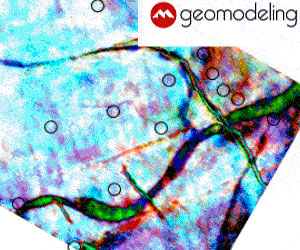Articles

A Survey of Geophysical Work Stations
Gordon Cope
An overview of Geophysical Work Stations available.
...
NSERC Funding of Earth Sciences Research in Canadian Universities: Current Status and Opportunities
Jeremy Hall
This article outlines current funding of geoscience research by the Natural Sciences and Engineering Research Council of Canada (NSERC), and opportunities for enhancing researchers access to its programs, especially the University-Industry Program.
...
Geophysicists Under 30
Nattalia Lea
Over the next three months, the CSEG Recorder will be publishing a three-part series of articles sampling the progression of a few geophysicists throughout their careers - how they manage change and conflict, and perceive their future. We will interview young geophysicists under 30 years of age, established geophysicists between…

Seismic Data Quality Inspection (QI) Procedures
In view of increasing concern about possible abuses of the quality inspection procedure for seismic data, the Canadian Society of Exploration Geophysicists and the Canadian Geophysical Brokers Association set up a joint committee to make recommendations concerning these procedures. Their recommendations were adopted by the CSEG executive in 1987 and…

Suggested Generic Standard for SEGY Files of Stacked Data
Although the SEC standard for SECY does not apply to stacked data, stacks have been stored on tape media for quite some time in a format roughly following the SEC publication. For tape media, the EBCDIC, the binary file header, and individual traces (single trace blocks) are put on tape,…

Anelasticity, Anisotropy and AVO
A.B. Haase
The assumption of perfect elasticity of rock materials is made routinely in the geophysical industry and in many, if not most, cases it is an adequate approximation. In making this assumption we ignore a fundamental feature of seismic waves propagating in the real earth which is the absorption of seismic…

How the Internet is Changing the Way Geophysicists Work
Nattalia Lea
Thirty-five years ago, American think tank visionary Paul Rand, announced to the world a concept for a public communications network which would evolve from a communications network linking computers of academic researchers. In 1981, the term Internet was coined for this communications network that would be accessible by personal computers…


Use of AVO and Residual Mapping to Delineate Gething Reservoir Sands in N.E. B.C.: An Integrated and Practical Approach
Karen Brawley-Hogg
This paper presents a seismic interpreter's approach to finding the Cretaceous Gething reservoir sands. A qualitative, practical, and affordable approach is discussed and integrated with geology and engineering. Benefits and pitfalls of the methods are reviewed.
...
Hot Offshore Plays
Gordon Cope
Recent low commodity prices may have dampened oil and gas exploration, but some spots around the globe remain popular.
...
Can You Read This in Three Minutes
Perry Kotkas
As First Vice President, I find out that it's my honour / responsibility / opportunity to "do an article for the Recorder" ... (If it's too long, nobody will read it, if it's too short, the Editor will kill me, and I have no great theme upon which to expound!)…

Doodlebug Golf Tournament
Maybe Bob Dylan said it best (although you may not have understood him) with the phrase: "Well, the times they are a changin" you probably heard them as "weeeeh, na taames...deharhaa jaajiin". The Doodlebug Golf Tournament is making a change of sorts.
...
The Impact of Low Oil Prices on the Canadian Geophysical Sector
Gordon Cope
Last month, the CSEG Recorder looked at the impact of low oil prices on the petroleum industry in North America. In our second part of the series, we look at the repercussions to the Canadian geophysical sector.
...
De-coding Y2K
Nattalia Lea
The apathy towards the Y2K bug has led some to believe that nothing is going to change except the year 2000, comes after midnight on December 31st this year. Despite the hoopla that the Y2K bug can or may cause, most dis-believers have a wait and see attitude. "I suppose…

Survey, Navigation and Positioning Guidelines for 3D Marine Seismic Survey Specifications
Bruce Calderbank
Guidelines for readily achievable survey, navigation and positioning specifications for 3D marine seismic surveys are provided in a check list type format detailing: the survey and configuration parameters; the type, quantity and criteria for the equipment; checks, verifications and calibrations; rejection and termination criteria; and deliverables. Each system or component…

Assessing Oil and Gas Future Production, and the End of Cheap Oil?
J.H. Laherrere
Reserve volumes are estimated and are therefore uncertain until the last day of production. In calculating reserves, different estimates will be obtained from the deterministic and probability methods of reserve estimation. Also, there is often confusion between defining reserves (expected production) and resources (potential in the ground). Furthermore, there is…

Towards The Next Millennium
Nattalia Lea
No doubt the petroleum industry has everyone on edge. Higher oil prices have failed to materialize and layoffs have once again become a fact of life. Downturns are a trademark of this business, while eternal optimists only speculate that an upswing is just around the corner. Not that anybody can…

The Oil Crisis – The Big Picture
Gordon Cope
Steve Curtis is a 44-year old geophysicist based in Calgary, Canada. For the last 20 years, he has explored for oil and natural gas in the Canadian oilpatch, as well as internationally, in Australia and Southeast Asia. In early February, Curtis and half a dozen other exploration staff were called…

3-D Seismic Acquisition Techniques in Culturally Difficult Areas
Kevin Pelletier
Late 1970's 2-D exploration in northern Canada revealed a pinnacle reef structure, in the "Leduc" formation. The structure appeared to be promising, but Mobil Oil of Canada, who owned the exploration rights, was uncertain of the commercial value of the property. By 1996 favorable market conditions, coupled with decreasing costs…

The Application of Multibeam Mapping to Hydrocarbon Exploration and Production
R.A. Pickrill
The development of multibeam mapping, (swath mapping), has been one of the most significant technological advance for marine geologists over the last 15 years. Traditional hydrographic surveys with single incidence echo sounders relied on a grid of tracks, between which data was interpolated. Multibeam systems replaced the Single transducer with…









